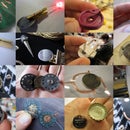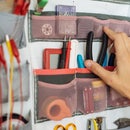Introduction: Stroke Sensor
This sensor takes some time to make. Repeatedly threading, stitching and cutting thread. But the result is quite effective and you can vary the design of the sensor in order to detect different kinds of stroke. See illustration for variations in stroke sensor design.
Various techniques could be applied to create this kind of "stroke sensor" such as knitting or crocheting loop stitch or rug knotting techniques. This Instructable shows how to stitch conductive 117/17ply silver plated nylon thread and a more resistive 66 Yarn 22+3ply 110 PET thread into neoprene in order to create a "stroke sensor". The rubberiness of the neoprene creates enough friction so that the threads will not come loose when stroking. Meaning you don't have to knot each individual hair. It is important to use these particular threads as thicker conductive threads tend to curl when repeatedly stroked and thus don't work for the stroke sensing anymore.
The publication DIY Wearable Technology also contains information on this sensor and can be downloaded from:
>> http://plusea.at/downloads/DIYWearableTec.pdf
HOW TO GET WHAT YOU WANT:
Loop stitch technique post >> www.kobakant.at/DIY/
Stroke sensor post >> www.kobakant.at/DIY/
VIDEO
Various techniques could be applied to create this kind of "stroke sensor" such as knitting or crocheting loop stitch or rug knotting techniques. This Instructable shows how to stitch conductive 117/17ply silver plated nylon thread and a more resistive 66 Yarn 22+3ply 110 PET thread into neoprene in order to create a "stroke sensor". The rubberiness of the neoprene creates enough friction so that the threads will not come loose when stroking. Meaning you don't have to knot each individual hair. It is important to use these particular threads as thicker conductive threads tend to curl when repeatedly stroked and thus don't work for the stroke sensing anymore.
The publication DIY Wearable Technology also contains information on this sensor and can be downloaded from:
>> http://plusea.at/downloads/DIYWearableTec.pdf
HOW TO GET WHAT YOU WANT:
Loop stitch technique post >> www.kobakant.at/DIY/
Stroke sensor post >> www.kobakant.at/DIY/
VIDEO
Step 1: Materials and Tools
MATERIALS
For sensor:
* Conductive thread- Silver Plated Nylon thread, 117/17 2ply
* Resistive thread - 66 Yarn 22+3ply 110 PET
both from LessEMF: lessemf.com/fabric.html
* Stretch conductive fabric
* Fusible interfacing
For circuit:
* 1.5 mm thick neoprene with polyester jersey laminated to either side from SedoChemicals: www.sedochemicals.de
* LilyPad sewable LED
* Sewable coin cell holder
both from Sparkfun: www.sparkfun.com/commerce/product_info.php
* 3V coin cell
TOOLS
- Sewing needle
- Scissors
- Iron
For sensor:
* Conductive thread- Silver Plated Nylon thread, 117/17 2ply
* Resistive thread - 66 Yarn 22+3ply 110 PET
both from LessEMF: lessemf.com/fabric.html
* Stretch conductive fabric
* Fusible interfacing
For circuit:
* 1.5 mm thick neoprene with polyester jersey laminated to either side from SedoChemicals: www.sedochemicals.de
* LilyPad sewable LED
* Sewable coin cell holder
both from Sparkfun: www.sparkfun.com/commerce/product_info.php
* 3V coin cell
TOOLS
- Sewing needle
- Scissors
- Iron
Step 2: Material Preparations
Cut out a piece of neoprene as large as you want the sensor to be. Cut two strips of stretch conductive fabric with fusible interfacing adhered to one side and fuse them opposite ends of the back side of the neoprene. See photos for reference.
Step 3: Thread Needle, Stitch, Cut
Thread a sewing needle with the conductive thread and take it double-double, so that two strands of thread are going through the needle hole. This is a way to save time and effort since you'll be able to stitch four threads in one go. Of course you can also stitch a single thread at a time.
Start by stitching through from the front side of the neoprene where the conductive fabric is adhered to the back. Make sure the thread goes all the way through the neoprene and makes contact with the conductive fabric before coming out the front again. Then cut all four threads to roughly equal lengths - depending on sensor design - about 2-3cm.
Repeat this over and over again until both conductive fabric strips have "hairs" connected to them. See photos.
Now thread the resistive thread the same way and repeat the same technique over again but this time fill the surface area in between the two conductive thread/fabric strips. See photos.
When you are finished with this, your sensor is finished, in order to see results continue with step three. or simple use alligator clips, an LED or a multimeter or an analog to digital converter to read sensor values.
Start by stitching through from the front side of the neoprene where the conductive fabric is adhered to the back. Make sure the thread goes all the way through the neoprene and makes contact with the conductive fabric before coming out the front again. Then cut all four threads to roughly equal lengths - depending on sensor design - about 2-3cm.
Repeat this over and over again until both conductive fabric strips have "hairs" connected to them. See photos.
Now thread the resistive thread the same way and repeat the same technique over again but this time fill the surface area in between the two conductive thread/fabric strips. See photos.
When you are finished with this, your sensor is finished, in order to see results continue with step three. or simple use alligator clips, an LED or a multimeter or an analog to digital converter to read sensor values.
Step 4: Complete Circuit
Your sensor is done, but by connecting an LED and a battery you can see how it works. Connect as follows, sewing with conductive thread:
End of one of the conductive fabric strips -- to -- Negative LED lead
Positive LED lead -- to -- Positive battery holder lead
Negative battery holder lead -- to -- End of the other conductive fabric strip
Now when you stroke the sensor you will see how the LED lights up brighter the greater the surface you stroke and the harder you stroke.
Enjoy!
End of one of the conductive fabric strips -- to -- Negative LED lead
Positive LED lead -- to -- Positive battery holder lead
Negative battery holder lead -- to -- End of the other conductive fabric strip
Now when you stroke the sensor you will see how the LED lights up brighter the greater the surface you stroke and the harder you stroke.
Enjoy!




